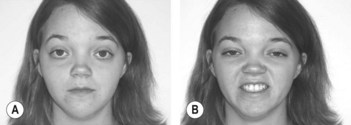66 Myasthenia gravis
Instruction
This patient complains of drooping of the eyelids in the evenings; examine this patient.
Salient features
History
• Weakness in muscles is more marked in the evening
• Muscle weakness which increases with exercise (remember that fatigability is the hallmark of myasthenia gravis) and is painless
• Muscle weakness affects smiling (Fig. 66.1), chewing, speaking, muscles of the neck, walking, breathing, movements at the elbow and hand movements
• Obtain history of thyrotoxicosis, diabetes mellitus, rheumatoid arthritis, SLE and thymoma
• Ask about d-pencillamine treatment for rheumatoid arthritis (myasthenia gravis is sometimes caused by d-pencillamine).
Examination
• The patient may have obvious ptosis
• Check for worsening of ptosis after sustained upward gaze for at least 45 s
• Check extraocular movements for diplopia and variable squint
• Comment on snarling face when the patient attempts to smile
• Weakness without loss of reflexes or alteration of sensation or coordination. The weakness may be generalized; it may affect the limb muscles, often proximal in distribution, as well as the diaphragm and neck extensors
• Muscle wasting is rare and when present inidicates it is late in the disease
Questions
What investigations would you like to do in this patient?
• Edrophonium (Tensilon) test. Edrophonium is a short-acting acetylcholinesterase inhibitor that gives an immediate increase in muscle strength (Fig. 66.2)
• Imaging of the mediastinum: chest radiography, CT or MRI of the chest
• Serum acetylcholine receptor antibodies (present in >80% of cases) (J Neurol Neurosurg Psychiatry 1985;48:1246–52). Remember that the basic deficit is a deficiency of acetylcholine receptors at the neuromuscular junction (Science 1973; 182:293–5); 50% have antibodies directed against muscle-specific kinase receptors
• Plasma thyroxine (to rule out an associated thyroid disorder)
• Anti-striated muscle antibody (seen in association with thymoma)
• Anti-nuclear antibody, rheumatoid factor and anti-thyroid antibodies may be positive
• Tuberculin test if immunosuppressive therapy is contemplated
• Electromyography (EMG): abnormalities include a decremental response to tetanic train stimulation at 5–10 Hz, and evidence of neuromuscular blockade in the form of jitter and blocking of motor action potentials in single-fibre EMG (Muscle Nerve 1992;15:720–4).
Stay updated, free articles. Join our Telegram channel

Full access? Get Clinical Tree



